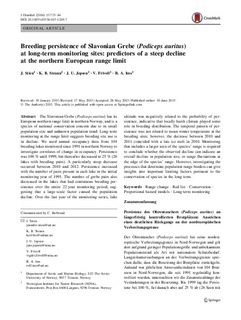| dc.contributor.author | Stien, Jenny | |
| dc.contributor.author | Strann, Karl Birger | |
| dc.contributor.author | Jepsen, Jane Uhd | |
| dc.contributor.author | Frivoll, Vigdis Irene | |
| dc.contributor.author | Ims, Rolf Anker | |
| dc.date.accessioned | 2016-03-17T14:15:23Z | |
| dc.date.accessioned | 2016-03-18T09:13:43Z | |
| dc.date.available | 2016-03-17T14:15:23Z | |
| dc.date.available | 2016-03-18T09:13:43Z | |
| dc.date.issued | 2015 | |
| dc.identifier.citation | Journal of Ornithology 2015, 157(1):75-84 | nb_NO |
| dc.identifier.issn | 2193-7206 | |
| dc.identifier.uri | http://hdl.handle.net/11250/2382461 | |
| dc.description.abstract | The Slavonian Grebe (Podiceps auritus) has its
European northern range limit in northern Norway, and is a
species of national conservation concern due to its small
population size and unknown population trend. Long-term
monitoring at the range limit suggests breeding site use is
in decline. We used annual occupancy data from 104
breeding lakes monitored since 1991 in northern Norway to
investigate correlates of change in occupancy. Persistence
was 100 % until 1999, but thereafter decreased to 25 % (26
lakes with breeding pairs). A particularly steep decrease
occurred between 2010 and 2012. Persistence increased
with the number of pairs present in each lake in the initial
monitoring year of 1991. The number of grebe pairs also
decreased in the lakes that had continuous breeding persistence
over the entire 22-year monitoring period, suggesting
that a large-scale factor caused the population
decline. Over the last year of the monitoring series, lake
altitude was negatively related to the probability of persistence,
indicative that locally harsh climate played some
role in breeding distribution. The temporal pattern of persistence
was not related to mean winter temperature at the
breeding sites; however, the decrease between 2010 and
2011 coincided with a late ice melt in 2010. Monitoring
that includes a larger area of the species’ range is required
to conclude whether the observed decline can indicate an
overall decline in population size, or range fluctuations at
the edge of the species’ range. However, investigating the
processes that determine population range borders can give
insights into important limiting factors pertinent to the
conservation of species in the long term. | nb_NO |
| dc.language.iso | eng | nb_NO |
| dc.rights | Navngivelse-Ikkekommersiell-DelPåSammeVilkår 3.0 Norge | * |
| dc.rights.uri | http://creativecommons.org/licenses/by-nc-sa/3.0/no/ | * |
| dc.subject | Range change | nb_NO |
| dc.subject | Red list | nb_NO |
| dc.subject | Conservation | nb_NO |
| dc.subject | Proportional hazard models | nb_NO |
| dc.subject | Long-term monitoring | nb_NO |
| dc.title | Breeding persistence of Slavonian Grebe (Podiceps auritus) at long-term monitoring sites: predictors of a steep decline at the northern European range limit | nb_NO |
| dc.type | Peer reviewed | nb_NO |
| dc.type | Journal article | |
| dc.type | Journal article | |
| dc.date.updated | 2016-03-17T14:15:23Z | |
| dc.source.pagenumber | 75-84 | nb_NO |
| dc.source.volume | 157 | nb_NO |
| dc.source.journal | Journal of Ornithology | nb_NO |
| dc.source.issue | 1 | nb_NO |
| dc.identifier.doi | 10.1007/s10336-015-1249-7 | |
| dc.identifier.cristin | 1341373 | |

